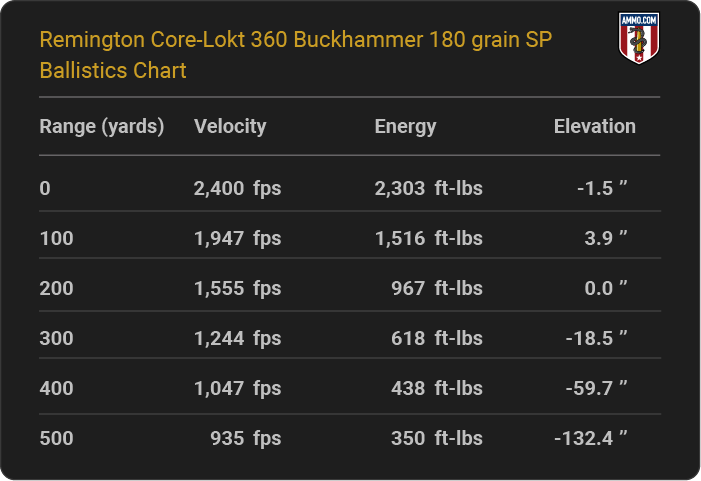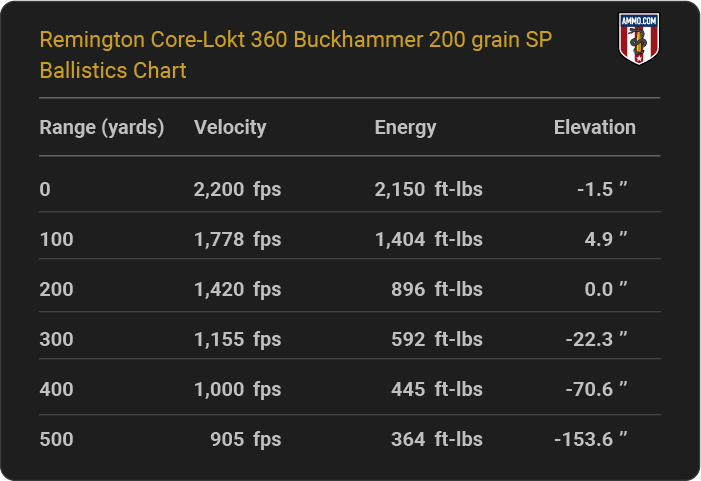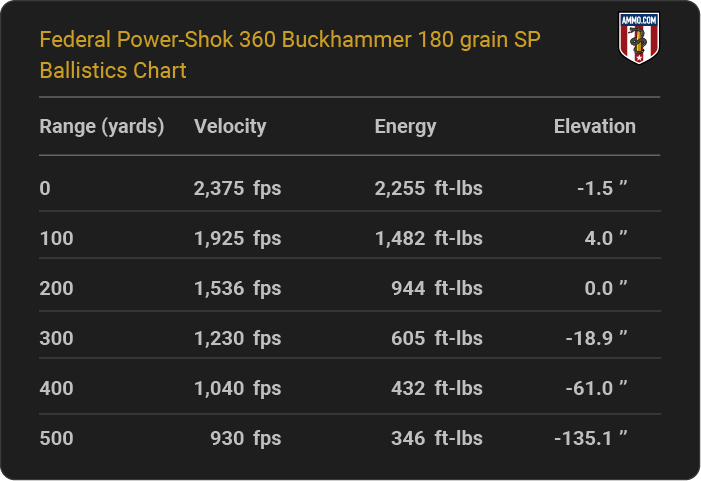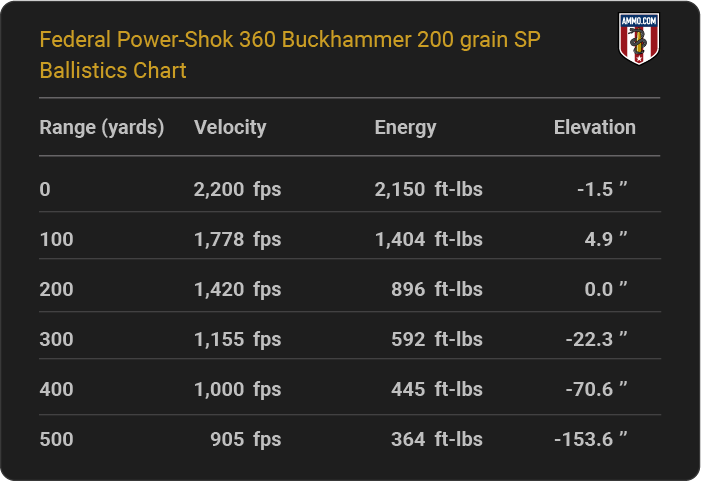.360 Buckhammer Ballistics for All Major Manufacturers in 2024
The Remington 360 Buckhammer is a straight-walled cartridge that allows shooters in Michigan, Ohio, and Indiana to hunt deer, hogs, and other medium-sized game. If you’re interested in .360 Buckhammer ballistics, this article is exactly what you need.
.360 Buckhammer Ballistics Charts
Jump to an ammo company: Remington | Federal
Remington Ammunition Ballistics - 360 Buckhammer
Jump to a ballistics chart: Remington Core-Lokt 360 Buckhammer 180 grain SP | Remington Core-Lokt 360 Buckhammer 200 grain SP
Remington Core-Lokt 360 Buckhammer 180 grain SP Ballistics Chart

Remington Core-Lokt 360 Buckhammer 200 grain SP Ballistics Chart

Federal Ammunition Ballistics - 360 Buckhammer
Jump to a ballistics chart: Federal Power-Shok 360 Buckhammer 180 grain SP | Federal Power-Shok 360 Buckhammer 200 grain SP
Federal Power-Shok 360 Buckhammer 180 grain SP Ballistics Chart

Federal Power-Shok 360 Buckhammer 200 grain SP Ballistics Chart

.360 Buckhammer Ballistics Trajectory Chart
A bullet’s flight path from barrel to target is its trajectory. We measure the trajectory by how much bullet drop occurs over a certain distance.
The following chart will help you better understand the .360 Buckhammer’s trajectory.

Note: The trajectory differs depending on the bullet. This chart represents only one cartridge.
By design, a straight-walled cartridge won’t have nearly as high a velocity as other popular rifle cartridges like the .308 Winchester. However, the .360 Buckhammer does have a higher velocity than others in its class (350 Legend, 450 Bushmaster, etc.).
The Remington Core-Lokt 360 Buckhammer 180-grain SP will keep a pretty flat trajectory out to 200 yards, but it begins to drop quickly. Furthermore, it loses energy pretty quickly compared to bottle-necked cartridges. Ultimately, it isn’t a long-range cartridge, but it’s excellent for most deer hunters.
How the .360 Buckhammer Ballistics Compares to Other Rifle Calibers
There are many great hunting cartridges out there. Remington designed the .360 Buckhammer for lever guns in areas requiring straight-walled cartridges for hunting. So, it’s a niche caliber, and firearms chambered in .360 Buckhammer aren’t the most coveted option, but it is necessary for those who hunt in states restricting bottleneck cartridges.
Let’s compare the Buckhammer to other similar centerfire cartridges.
The .360 Buckhammer vs. 350 Legend
The 350 Legend is another straight-walled cartridge great for whitetail deer hunting in the Midwest. However, there are some notable differences between Winchester’s 350 Legend and Remington’s .360 BHMR.
To start, the 350 Legend has slightly less recoil. It’s also designed for AR-style rifles, while the .360 BHMR is designed for lever action rifles. On the other hand, the .360 Buckhammer has more energy at close ranges, but it still doesn’t quite go the distance of the 350 Legend.
For example, Federal Power-Shok 350 Legend 180-grain ammunition has a muzzle velocity of 2,100 fps and 1,762 ft-lbs of muzzle energy. On the other hand, Federal Power-Shok .360 Buckhammer has 2,375 fps of muzzle velocity and 2,254 ft-lbs of muzzle energy. While the latter has more energy at the muzzle, both have an effective range of 200 yards.
The .360 Buckhammer vs. 30-30
Naturally, I’ll compare the .360 Buckhammer to the 30-30 because they’re similar in size and performance. The .360 Buckhammer shoots a .358” diameter projectile in the 30-30 parent case, while the 30-30 shoots a .308” projectile from a .38-55 Winchester parent case.
Let’s look at the Remington Core-Lokt first. The Core-Lokt 30-30 Win 150-grain bullet has 2,390 fps of muzzle velocity and 1902 ft-lbs of energy. The effective range of this bullet is just under 200 yards.
On the other hand, Remington Core-Lokt 360 Buckhammer 180-grain bullet has a higher muzzle velocity of 2,400 fps and 2,302 ft-lbs of muzzle energy. The effective range is nearly identical at 200 yards.
The .360 Buckhammer has slightly more bullet drop at 200 yards but also has more pressure and shoots heavier bullets. However, the 30-30 has less recoil.
The .360 Buckhammer vs. 35 Remington
The new .360 Buckhammer cartridge hasn’t been around long, but we can compare it to the much older 35 Remington because they’re both similar in size. While the 35 Remington is a rimless bottle-neck cartridge and the .360 Buckhammer is a rimmed cartridge, the two have similar specs.
The 35 Remington has a 30-06 Springfield parent case, and the .360 Buckhammer has the 30-30 as the parent case, with nearly identical case lengths (1.92” vs. 1.8”). Furthermore, both shoot a .358” diameter projectile.
.360 Buckhammer Muzzle Velocity and Muzzle Energy
By design, a straight-walled cartridge won’t have nearly as high a velocity as other popular rifle cartridges like the .308 Winchester. However, the .360 Buckhammer does have a higher velocity than others in its class (350 Legend, 450 Bushmaster, etc.).
It’s essential to look at a hunting cartridge's muzzle velocity and energy because it gives you an idea of the effective range and the knock-down power. Of course, other factors play into choosing the best hunting ammo, but the muzzle velocity and energy are a great place to start.
There aren’t as many .360 Buckhammer ammo options as other cartridges because it’s still a new cartridge, but we typically see between 2,200 and 2,400 fps (feet per second) of muzzle velocity.
For example, the 180-grain Federal Power-Skok Jacketed Soft Point has a muzzle velocity of 2,374 fps and 2,252 ft-lbs of muzzle energy. The 180-grain Remington Core-Lokt is a bit faster, with 2,400 fps muzzle velocity and 2,302 ft-lbs of muzzle energy.
Frequently Asked Questions
When you understand the specs and ballistics of your deer cartridges, choosing the best rifle is pretty simple. If you have more questions about the new 360 Buckhammer, keep reading.
What is the effective range of a .360 Buckhammer?
The effective range of the .360 Buckhammer is 200 yards.
Is the .360 Buckhammer better than the 30-30?
Not necessarily. The 30-30 has a better trajectory, but the .360 Buckhammer has more stopping power at closer distances.
How much recoil does a .360 Buckhammer have?
The .360 Buckhammer has 14.1 ft-lbs of recoil. For comparison, the 30-30 only has 9.97 ft-lbs.
Is it easy to find .360 Buckhammer ammo?
No. .360 Buckhammer loads aren’t nearly as easy to find as other cartridges, so reloading will be a valuable skill.
Is the .360 Buckhammer only chambered in single-shot rifles?
No. Henry Repeating Arms unveiled a semiautomatic carbine at the 2023 SHOT Show.
Is the .360 Buckhammer good for black bears?
Yes, as long as it’s within the effective range.
Is the .360 Buckhammer good for big game?
Not particularly. The Buckhammer doesn’t have enough energy to take down big game outside of very short distances.
Ballistic Charts
- 308 Ballistics Charts
- 6mm ARC Ballistic Charts
- 10mm Auto Ballistics Charts
- 224 Valkyrie Ballistics Charts
- 204 Ruger Ballistics Charts
- 30-30 Ballistics Charts
- 6.8 SPC Ballistics Charts
- 350 Legend Ballistics Charts
- 300 Blackout Ballistics Charts
- FN 5.7x28 Ballistic Charts
- 7.62x39 Ballistics Charts
- 22 Creedmoor Ballistics Charts
- 300 PRC Ballistics Charts
- .360 Buckhammer Ballistics Charts
- 8.6 Blackout Ballistics Charts
- 30-06 Ballistics Charts
- 44 Magnum Ballistics Charts
- 7mm-08 Ballistics Charts
- 7mm Rem Mag Ballistics Charts
- 300 Win Mag Ballistics Charts
- 270 Win Ballistics Charts
- 45 Long Colt Ballistics Charts
- 6.5 Creedmoor Ballistics Charts
- 40 S&W Ballistics Charts
- 243 Win Ballistics Charts
- 357 Magnum Ballistics Charts
- 380 ACP Ballistics Charts
- 45 ACP Ballistics Charts
- 223 Rem Ballistics Charts
- 450 Bushmaster Ballistics Charts
- 400 Legend Ballistics Charts
- 5.56 Ballistics Charts
- 9mm Ballistics Charts
- 28 Nosler Ballistics Charts
- 45-70 Ballistics Charts
- 6.5 PRC Ballistics Charts
- 22-250 Ballistics Charts
- 22 Hornet Ballistics Charts
- 7mm PRC Ballistics Charts
- 22 ARC Ballistics Charts
- 6.8 Western Ballistics Charts
